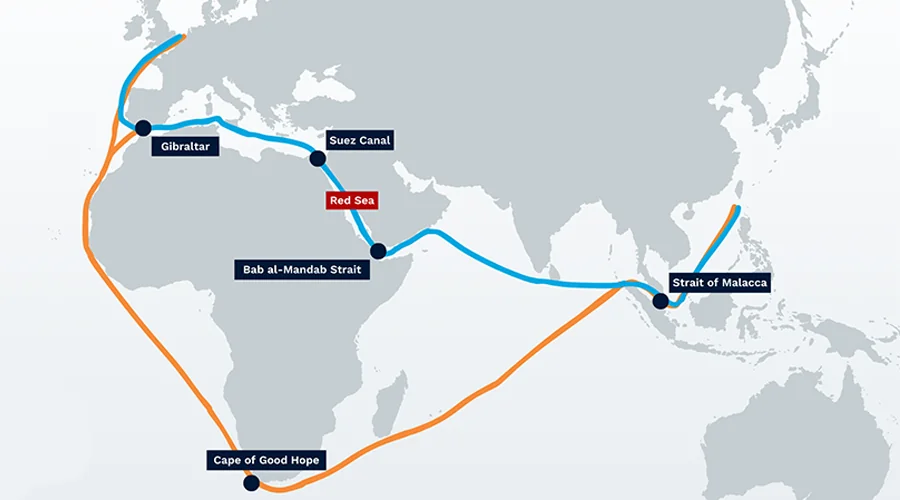Rebel Attacks
Iran-backed Houthi rebels have seized control of most of Yemen and the capital Sanaa since 2014. Since shortly before Oct 7, the Houthis have been sporadically attacking commercial vessels in the Red Sea, which has only escalated since the start of the Israel-Hamas war. The Houthis strategy has been to use drones and anti-ship missiles to attack ships, along with a helicopter to seize and board an Israeli vessel.
The Houthis are specifically targeting any vessel going to or leaving Israel, with their initial motives being to show “solidarity” with the Palestinians and call for a ceasefire. Now, Houthis are attacking any vessels, no matter the origin, and attacking everything from container ships to oil tankers. The US, UK, and other countries have responded with airstrikes at sea and on land. The Red Sea chaos has forced shipping traffic to reroute away from the Suez Canal and instead take a lengthy course around the southern tip of Africa, the Cape of Good Hope.
As a result, these disruptions have led to lengthy delays and increased shipping costs, adding to the financial struggles already faced due to inflation. Most ships being rerouted have around 10,000 containers aboard; think of the headaches when replanning routes- endless emails and phone calls to get shipments back up to speed.
Red Sea Importance
The Red Sea is an incredibly critical shipping route for most of the world. Around 40% of trade between Asia and Europe traverses the Red Sea, with Europe relying heavily on oil and diesel fuel. Palm oil, grain, and most manufactured products, such as toys and electronics, rely on the Red Sea route. The Suez Canal accounts for about 12% of the world’s trade, along with 30% of global container traffic and over 1 million barrels of crude oil per day, according to Freightos Group.
Shipping Lane Chaos
It is estimated that, at a minimum, 90% of container ships are rerouting around the Cape of Good Hope. The cost to ship a standard 40-foot container from China to Northern Europe has increased by thousands of dollars. However, current rates are still much less expensive than during the pandemic. Experts believe the industry will adjust to the reality of rerouting around the Cape, with manufacturers needing to prepare and plan for delays.
Global Trade Consequences
While pressure on oil prices is expected to increase, some believe energy supply shock is not inevitable. Conversely, global energy will likely face massive implications if the conflict escalates to the Strait of Hormuz. The pandemic fueled an enormous spending spree by global consumers, which increased demand and led to supply chain delays. With the Red Sea conflict, ocean carriers are often at capacity, decreasing the issue of supply and demand experienced during the pandemic. Following the Red Sea attacks, shipping prices have skyrocketed, affecting consumers. Even shippers booking at contract rates face higher rates than usual, as emergency surcharges are added to invoices.
Even though carriers are often at capacity, the rerouting strategies caused by the conflict create significant delays and longer transit times. Huge companies like Tesla, Volvo, and Michelin have even been forced to halt production due to the new shipping timelines. At the same time, Ikea, among others, has cautioned consumers of product delays on the horizon. The delays in container arrivals have significantly affected manufacturing and product availability. As a result, some companies have considered near-shoring strategies and diversifying their production sources.
Most vessels have approximately 15-25 people on board whose lives are in immediate danger during Red Sea transit, leading most shipping firms to avoid the area altogether. Hundreds of ships have chosen to detour despite the logistical headache and time-consuming nature of it all. Rerouting is a crucial decision to help prevent threats to human life, legal issues, unpredictable delays, and increased insurance premiums.
It is predicted that even once the conflicts have ended, it will take several months to reposition ships and equipment and restore regular transportation networks.
Route Alternatives
Rerouting vessels around the Cape of Good Hope adds approximately 3,500 miles and 10-12 extra days of sailing time, and, of course, a lot of extra fuel, around $1m extra, according to the estimates. This leads to the continued adjustments of delivery times and seeking out alternative ports of call. Most companies would rather pay the financial price than risk the Houthi attacks. Most experts believe the Houthi attacks might last for months but do not believe the conflict will last for years.
Aside from the reroute around the Cape of Good Hope, carriers send cargo via air freight. Some companies, such as France-based food producer Danone, will resort to air freight if the conflict continues over the coming months. Another method gaining more popularity is the hybrid sea-air mode. The hybrid sea-air mode provides faster transit times than ocean shipping and at a more economical price than pure air transit. While air freight can be 13-15x more expensive than ocean shipping, many businesses find this method more economical than investing in additional inventory.
Longer voyages lead to unsynchronized port schedules, leading to congestion in areas like Northern Europe. Some carriers have skipped port calls to stay on schedule. Another challenge is that of repositioning empty containers back to Asia. This challenge has led to container shortages at the point of origin and a slowing of the rate of outbound shipments.
Far-Reaching Consequences
The chaos ensuing in the Red Sea has negatively affected companies and consumers globally. The crisis has threatened human lives, affected vessel capacity, increased shipping costs, and created disruptions while causing logistical pain and headaches. Amidst the crisis, companies are adapting and finding new ways to manage their supply chains while meeting consumer needs.

